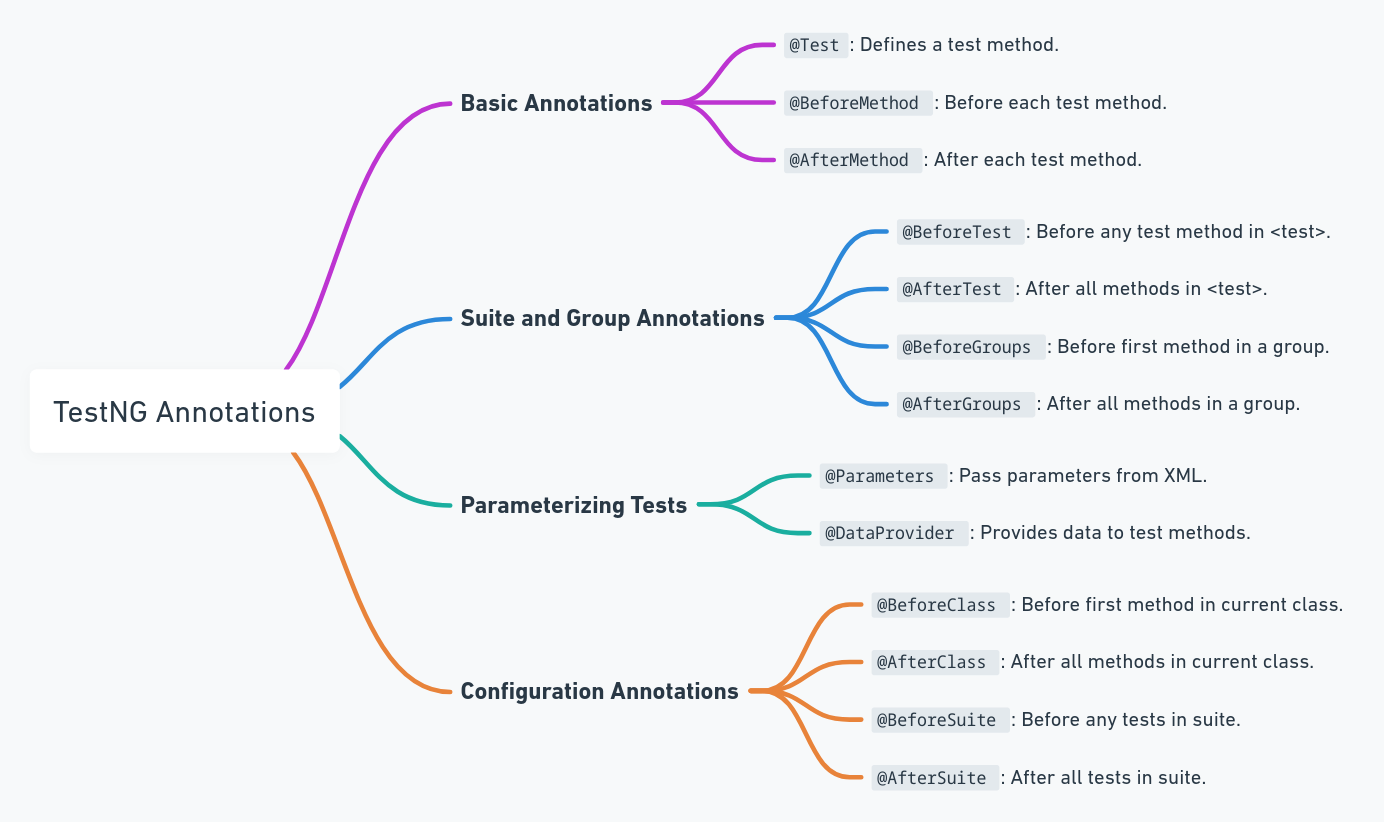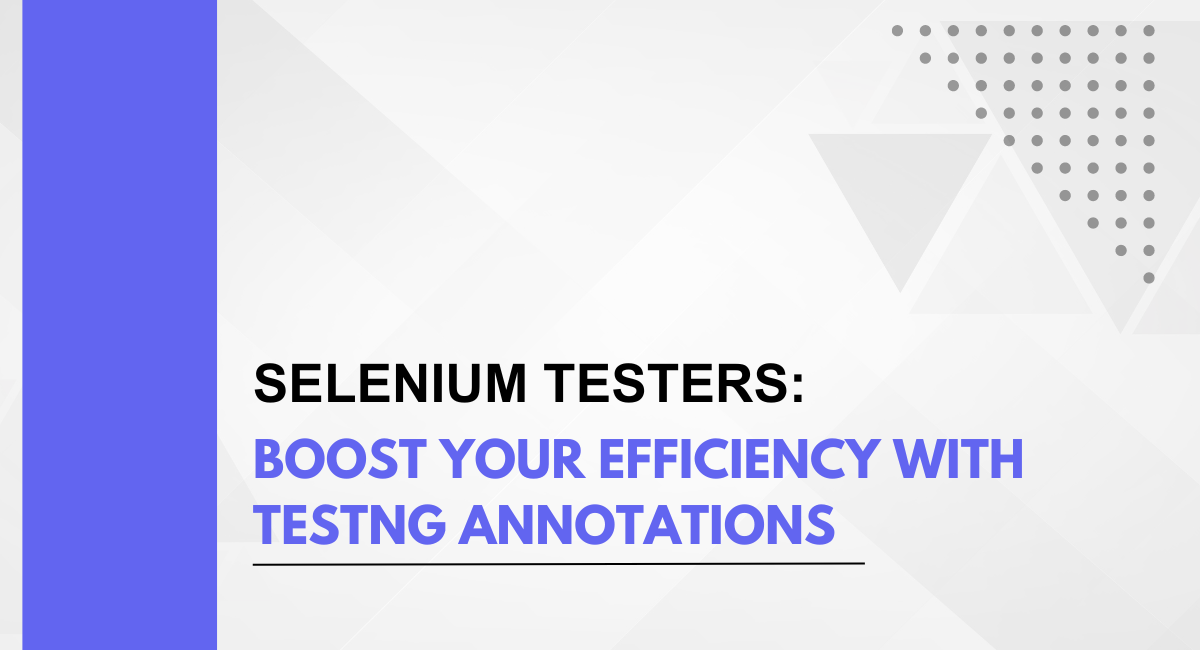Feeling the pinch of repetitive code in your Selenium tests? Imagine a toolbox filled with superpowers that streamline your workflow and make you a testing ninja. Well, fret no more, Selenium testers! TestNG annotations are your secret weapons. These special markings within your code unlock a range of efficiencies, from organizing tests to managing data and even controlling execution flow.
We'll delve into the world of TestNG annotations, showing you how to supercharge your Selenium tests and become a more productive and powerful test automation expert.
Edsger Dijkstra jokingly remarks ”If debugging is the process of removing software bugs, then programming must be the process of putting them in." Testing is an indispensable component of software development, ensuring that applications meet the desired standards of quality and performance.
Selenium testing has emerged as a cornerstone for automating web browsers to validate web applications across different platforms. This article provides a concise exploration of Selenium testing, emphasizing the significance of efficiency in the testing process and introducing TestNG annotations as a pivotal tool for enhancing test automation.
Selenium is an open-source tool widely used for automating web browsers and testing web applications. It facilitates the creation of robust test scripts in various programming languages, including Java, Python, and C#. Selenium's suite of tools encompasses Selenium WebDriver, Selenium IDE, and Selenium Grid, catering to different aspects of web testing.
With Selenium WebDriver being the most popular component, developers can interact with web elements, simulate user actions, and perform functional testing across multiple browsers and platforms.
Understanding TestNG Annotations
TestNG annotations are markers used in Java code to indicate how methods should be run or treated during test execution. They provide instructions to TestNG on how to manage test cases, set up test environments, handle dependencies, and generate reports. By leveraging annotations, developers can customize the behavior of their test suites and ensure efficient test execution.
Commonly Used TestNG Annotations by Selenium Testers

- @Test: Marks a method as a test case.
- @BeforeSuite: Executes once before all tests in a suite.
- @AfterSuite: Executes once after all tests in a suite.
- @BeforeClass: Executes once before the first test method in a class.
- @AfterClass: Executes once after all test methods in a class.
- @BeforeMethod: Executes before each test method.
- @AfterMethod: Executes after each test method.
- @DataProvider: Supplies test data to test methods.
- @Parameters: Provides parameters to test methods.
- @Listeners: Listens to events in the test lifecycle.
Boosting Efficiency with TestNG Annotations
Efficiency is key in software testing, and TestNG annotations offer a robust framework for enhancing the efficiency of Selenium test suites. By leveraging various TestNG annotations, developers can streamline test organization, execute tests in parallel, implement data-driven testing, and manage test prioritization and dependencies effectively.
Improved Test Organization
- Grouping Tests Using @Test Annotation: TestNG's @Test annotation allows developers to categorize test methods into logical groups, enabling better organization and easier management of test suites.
- Setting Up Preconditions Using @Before and @After Annotations: TestNG provides @Before and @After annotations to define setup and teardown procedures, ensuring that preconditions are met before test execution and cleanup tasks are performed afterward.
Parallel Execution of Tests
- Utilizing Parallel Execution Feature with TestNG: TestNG supports parallel execution of tests, allowing multiple test methods to run concurrently, thereby reducing overall test execution time.
- Advantages of Running Tests in Parallel: Parallel execution enhances efficiency by utilizing available resources more effectively, accelerating the feedback loop, and enabling faster identification of defects.
Data-Driven Testing
- Leveraging @DataProvider for Parameterized Testing: TestNG's @DataProvider annotation enables data-driven testing by supplying test data to test methods, enhancing test coverage and enabling testing with various input combinations.
- Enhancing Test Coverage and Reducing Redundancy: Data-driven testing minimizes redundant test code by parameterizing test cases, thereby improving test coverage and making tests more maintainable and scalable.
Test Prioritization and Dependency Management
- Using @Test(priority) to Prioritize Test Execution: TestNG allows developers to prioritize test methods using the @Test(priority) annotation, ensuring that critical tests are executed first, and less critical tests follow suit.
- Managing Test Dependencies Using dependsOnMethods and dependsOnGroups: TestNG annotations such as dependsOnMethods and dependsOnGroups enable developers to specify dependencies between test methods and groups, ensuring that tests are executed in the correct order and minimizing false positives.
TestNG annotations offer a powerful mechanism for boosting the efficiency of Selenium testing. By employing these annotations judiciously, developers can organize tests effectively, execute them in parallel, implement data-driven testing, and manage test prioritization and dependencies with ease, thereby optimizing the overall testing process.
Best Practices for Using TestNG Annotations
TestNG annotations are powerful tools for orchestrating and controlling the execution flow of test cases within the TestNG framework. To leverage these annotations effectively and ensure the stability and efficiency of your test suites, it's essential to follow best practices in their usage.
Naming Conventions for Annotations
Maintaining consistent and descriptive naming conventions for TestNG annotations enhances the readability and understandability of test code. Choose meaningful names that accurately reflect the purpose or behavior associated with each annotation to make it easier for developers to comprehend the intent behind the annotations.
Proper Usage of Annotations to Maintain Test Stability
Exercise caution when applying annotations to ensure that they contribute to the stability and reliability of your tests. Avoid overuse or misuse of annotations, as excessive annotations can lead to code clutter and increased complexity. Use annotations judiciously to define preconditions, postconditions, and test configurations, focusing on improving test stability and maintainability.
Organizing Test Suites Effectively
Adopt a systematic approach to organizing test suites using TestNG annotations to enhance maintainability and scalability. Group related tests using annotations such as @Test, @BeforeClass, @AfterClass, and @BeforeMethod to ensure logical grouping and coherent structure within your test suites. Maintain a clear hierarchy and organization of test classes and methods to facilitate easy navigation and management.
Handling Exceptions and Errors Gracefully
Implement error handling mechanisms within your test code to handle exceptions and errors gracefully. Utilize annotations such as @Test(expectedExceptions = Exception.class) to specify expected exceptions and ensure that tests fail only when unexpected errors occur. Incorporate logging and reporting mechanisms to capture relevant information about test failures and aid in debugging and troubleshooting efforts.
Integrating with Continuous Integration (CI) Tools
Integrate TestNG with Continuous Integration (CI) tools such as Jenkins, Travis CI, or CircleCI to automate the execution of test suites and incorporate testing into your development workflow seamlessly. Configure CI pipelines to trigger test execution automatically upon code commits or merges, enabling early detection of defects and ensuring continuous feedback to developers.
Incorporating these best practices into your TestNG test automation strategy empowers you to harness the full potential of TestNG annotations and optimize the efficiency and effectiveness of your testing processes. By adhering to established conventions and guidelines, you can maintain robust, stable, and maintainable test suites that facilitate the delivery of high-quality software products.
Advanced Techniques with TestNG Annotations
TestNG annotations offer a wealth of advanced capabilities beyond basic test organization and execution. By exploring advanced techniques, developers can further enhance the effectiveness and efficiency of their test automation efforts, leveraging TestNG's extensibility and flexibility to address diverse testing requirements.
Customizing Test Reports with Listeners
TestNG provides a robust mechanism for customizing test reports through the use of listeners. Listeners enable developers to intercept and react to various events occurring during test execution, such as test start, test success, test failure, and test completion.
By implementing custom listeners, developers can tailor test reports to their specific needs, incorporating additional information, formatting, or integration with external systems to enhance test visibility and analysis.
Extending TestNG Functionalities with Custom Annotations
While TestNG offers a comprehensive set of built-in annotations, developers can extend its functionalities by creating custom annotations tailored to their unique testing requirements. Custom annotations allow developers to encapsulate common testing patterns or configurations into reusable components, simplifying test code and promoting consistency across test suites.
By defining custom annotations, developers can streamline test development and maintenance while enhancing the expressiveness and readability of their tests.
Implementing Retry Mechanisms for Failed Tests
TestNG enables developers to implement retry mechanisms for failed tests, providing a robust approach to handle flaky tests or intermittent failures. By annotating test methods with the @Retry annotation and specifying the maximum number of retry attempts, developers can instruct TestNG to automatically rerun failed tests, increasing test reliability and reducing false positives.
Retry mechanisms help mitigate transient issues and ensure consistent test results across test executions, improving the overall robustness of test suites.
Integrating with Other Testing Frameworks or Tools
TestNG offers seamless integration with other testing frameworks or tools, allowing developers to leverage complementary technologies to address specific testing needs. Whether integrating with code coverage tools, performance testing frameworks, or browser automation libraries, TestNG's extensibility enables developers to build comprehensive testing solutions tailored to their project requirements.
By integrating TestNG with other tools and frameworks, developers can unlock additional capabilities and enhance the effectiveness of their test automation efforts.
By mastering these advanced techniques with TestNG annotations, developers can elevate their test automation practices to new heights, unlocking greater flexibility, scalability, and reliability in their testing processes. Whether customizing test reports, extending TestNG functionalities, implementing retry mechanisms, or integrating with other testing tools, TestNG provides a robust foundation for building sophisticated and effective test automation solutions.
Case Studies
Real-world examples and case studies provide invaluable insights into how TestNG annotations can be effectively applied to address common challenges and scenarios encountered in test automation. By examining practical implementations in diverse contexts, developers can gain inspiration and guidance for optimizing their own test automation strategies.
Case Study 1: Implementing Parallel Execution in a Large Test Suite
In this case study, a software development team faced the challenge of reducing test execution time for a large test suite comprising hundreds of test cases. By leveraging TestNG's parallel execution feature, the team was able to distribute test execution across multiple threads, significantly accelerating test completion. Through careful configuration and optimization, they achieved a substantial reduction in overall test execution time, enabling faster feedback and more efficient use of testing resources.
Case Study 2: Data-Driven Testing for Login Functionality
In another scenario, a team tasked with testing the login functionality of a web application sought to validate the system's behavior under various login scenarios. Employing TestNG's data-driven testing capabilities, they created a data provider supplying a range of valid and invalid login credentials.
By parameterizing their test methods and iterating over the supplied data, they systematically tested the login functionality with different input combinations, uncovering potential edge cases and enhancing test coverage.
Case Study 3: Prioritizing and Managing Dependencies in an E-commerce Test Suite
In this case study, a QA team responsible for testing an e-commerce platform encountered challenges related to test prioritization and dependency management. Using TestNG annotations such as @Test(priority) and dependsOnMethods, they prioritized critical test cases essential for validating core functionalities like product search, checkout, and payment processing.
By establishing dependencies between test methods to ensure proper execution order, they effectively managed test dependencies and minimized false positives, resulting in more reliable test results and improved test suite maintainability.
Boost Testing Efficiency
TestNG annotations serve as the backbone of Selenium testing, providing a structured and extensible framework for orchestrating test execution and managing test configurations. From organizing test suites to handling exceptions and integrating with Continuous Integration tools, TestNG annotations offer a comprehensive suite of features that empower developers to build robust and scalable test automation solutions.
You may also be interested in: Selenium vs Playwright: A Comprehensive Comparison
Book a Demo and experience ContextQA testing tool in action with a complimentary, no-obligation session tailored to your business needs.
We make it easy to get started with ContextQA tool: Start Free Trial.
